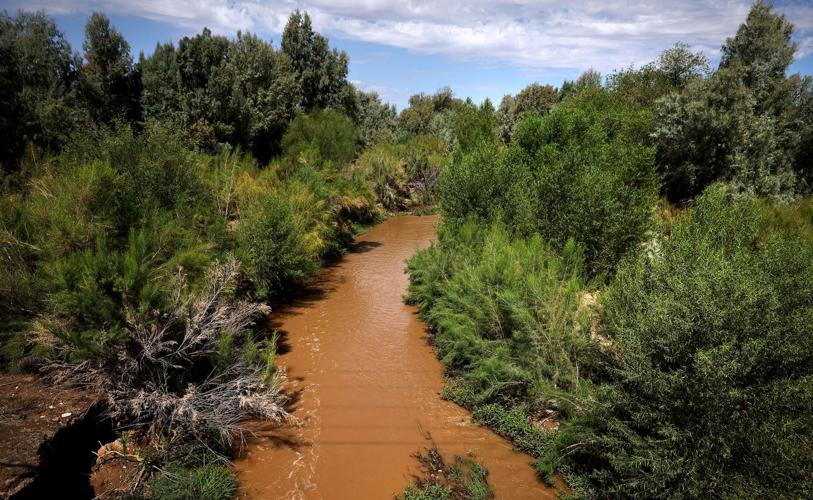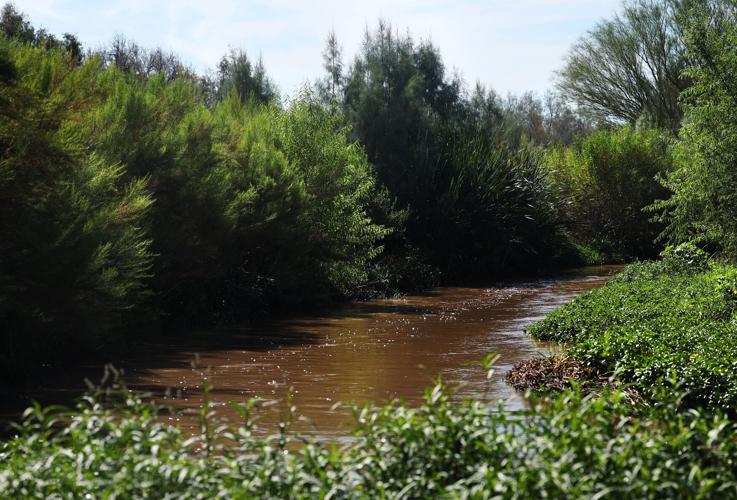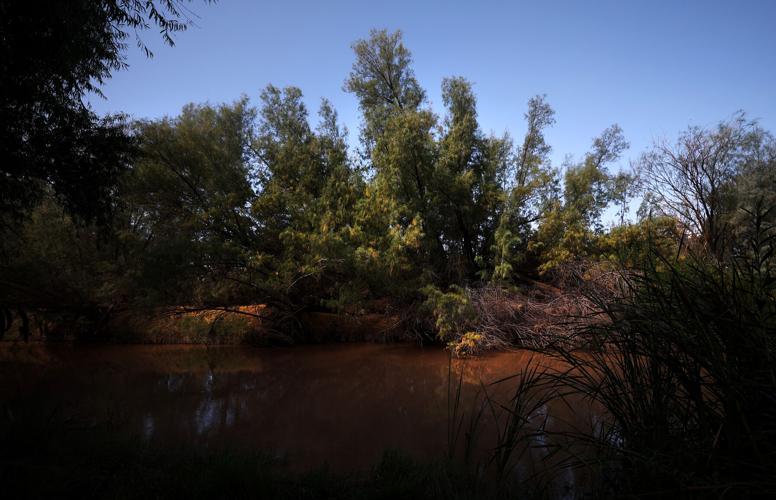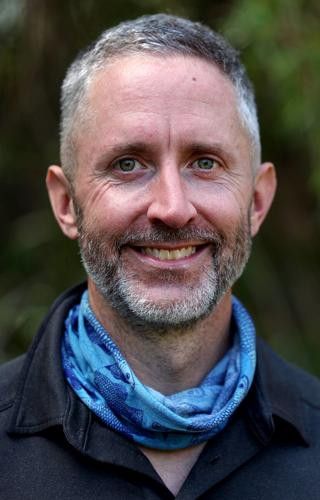On the Santa Cruz River just above the Sanders Road bridge in Marana, water flows past towering stands of native GoodingŌĆÖs willow trees on one bank and non-native tamarisks on the other.
Bird calls are constant, dominated by the clacking, chucking, peeping, mews and cackles of the yellow-breasted chat, one of several colorful warbler species that frequent this stretch of river.
Like everywhere else that the Santa Cruz carries water year-round through Southern Arizona, this stretch of river lives mainly on effluent, coming from a sewage treatment plant at Ina Road, about 18 miles upstream.
But the days are numbered for this stretch of river, Michael Bogan worries. HeŌĆÖs an associate professor of natural resources at the University of Arizona and an expert on the river, who has documented the presence of birds, dragonflies, fish and other wildlife in the effluent-watered stretches of the Santa Cruz for a decade.
People are also reading…
His immediate concern is about Project Blue, the proposed $3.6 billion data-centers project that private developers wish to build on TucsonŌĆÖs southeast side. The data centers will need water to cool their equipment, and officials have said the ultimate source will be reclaimed water, which is heavily treated sewage effluent.
For many reasons, Bogan thinks itŌĆÖs likely that sooner or later, the city of ┤¾Ž¾APPwill take some of the effluent now reaching this far north on the river to serve the needs of Project Blue.
City officials sharply dispute his assertion as false.
But they acknowledge that future plans to treat wastewater for drinking and transfer reclaimed water for various uses could jeopardize this stretch of river within five to seven years.

Bogan
On Monday, city officials released a 47-page proposed development agreement and a separate fact sheet spelling out Project BlueŌĆÖs water needs and potential supplies.
A day later, Bogan dashed off a four-page memo warning that serving reclaimed water to Project Blue likely will dry up three to five miles of river in the Marana area. He fears widespread losses of wildlife and its habitat.
Standing on the riverbank next to a huge spreading willow tree on Thursday morning, Bogan explained to the Star that he sees no way ┤¾Ž¾APPcan supply Project Blue with reclaimed water without taking at least some from the Santa Cruz in this area. The effluent at this point comes from Pima CountyŌĆÖs Tres Rios treatment plant at Ina Road.

The Santa Cruz River flows especially high and fast Thursday after a monsoon storm the day before at Sanders Road crossing in Marana. Michael Bogan, a University of Arizona associate professor, has monitored the Santa Cruz for years. He warns that Project Blue could dry up 3-5 miles of the river in the Marana area, hurting wildlife and damaging habitat. But ┤¾Ž¾APPofficials say thatŌĆÖs false.
His reasoning is complicated, stemming from the reality that when the effluent runs past the Trico Road bridge near the Pinal County line, three miles downstream of Sanders Road, the city gets no water supply benefit from recharging it into the aquifer.
Effluent that recharges into the riverbed in Pima County generates ŌĆ£creditsŌĆØ from the state to the city, allowing ┤¾Ž¾APPto pump that much groundwater elsewhere under ArizonaŌĆÖs water management system. But the city gets ŌĆ£zeroŌĆØ credits once the water enters Pinal County, ┤¾Ž¾APPCity Manager Tim Thomure told the Star.

The Santa Cruz River at Sanders Road crossing in Marana. A University of Arizona biologist worries that reclaimed water will be diverted from the river to support the proposed Project Blue data centers in Tucson, but city officials say theyŌĆÖve got plenty of reclaimed water elsewhere.
In the driest times of the year, the spot at Sanders Road is about as far north as the effluent-dominated river runs, said Bogan.
The credit issue gives the city an incentive to let some of the Santa Cruz effluent go to Project Blue, he said, so that it will be able to make use of the effluent rather than ŌĆ£losingŌĆØ it to Pinal County.
ŌĆ£100% of this part of the river could disappear tomorrow,ŌĆØ Bogan said.
The reclaimed water will be delivered to Project Blue via an 18-mile pipeline the company developing the data center complexes will build, leading from a city pump station at Mission Manor on TucsonŌĆÖs south side.
Thomure, however, said in an interview at his office Thursday afternoon that BoganŌĆÖs concerns are unjustified and his statements that reclaimed water for Project Blue will come from the river are false.
The city will be able to get plenty of reclaimed water for Project Blue from other sources without having to resort to river water, he said. One is reclaimed water that every year is added to Sweetwater Wetlands, an effluent recharge storage area that doubles as a renowned bird habitat near Pima CountyŌĆÖs Aqua Nueva sewage treatment plant on TucsonŌĆÖs northwest side.
A third is the ┤¾Ž¾APPAirport Rehabilitation Project, or TARP, that is treating contaminated groundwater on the south side and sends much or most of it to the cityŌĆÖs reclaimed water system.
The reclaimed water going to Project Blue wonŌĆÖt come from anywhere near the Tres Rios plant downstream, Thomure said. It will originate further upstream at the countyŌĆÖs Aqua Nueva treatment plant along Sweetwater Drive.
ŌĆ£His entire premise is false. His conclusions are false. His presentation is false,ŌĆØ Thomure said of BoganŌĆÖs paper. ŌĆ£His assumption that Project Blue would reduce flow in river is also false.ŌĆØ

Trees, birds and other wildlife are attractions along the Santa Cruz River in Marana that is fed by treated sewage effluent.
Bogan disagrees with ThomureŌĆÖs assessment of his concerns. He finds the cityŌĆÖs plans to use water from TARP and the Sweetwater Wetlands to serve Project Blue misguided at best and foolish at worst because he believes the water should be left in the river or stored for future generations.
Future water diversions
But where Bogan and Thomure would more likely agree is that regardless of what happens to Project Blue, the northern Santa CruzŌĆÖs days as an effluent-carrying river may indeed be limited, at least at times.
By the early 2030s, an $87 million federally funded project to take 2.3 million gallons a day out of the Santa Cruz to be treated for drinking ŌĆö through a process the city calls advanced water purification ŌĆö will be online. Around that same time, the city plans to change how it ships effluent to the Dove Mountain development in MaranaŌĆÖs Tortolita Mountains foothills in a way that will take more water from the Santa Cruz north of Ina Road.
And ultimately, if population growth, drought and Colorado River cutbacks make TucsonŌĆÖs water situation serious enough, the cityŌĆÖs government has gone on record in favor of seriously considering building a much bigger plant to treat wastewater for drinking, a process also known as direct potable water reuse.
If that happens ŌĆö and ┤¾Ž¾APPWater Director John Kmiec said it could be ŌĆ£decadesŌĆØ off ŌĆö much more water will come out of the Santa Cruz.
Bogan has promoted city efforts
For Bogan to be speaking out against Project Blue is a 180-degree shift in his stance toward city of ┤¾Ž¾APPactivities.
Starting in 2019, when Thomure, as ┤¾Ž¾APPWater director, launched the Santa Cruz River Heritage Project to discharge effluent in the river south of downtown, Bogan was one of that projectŌĆÖs most vocal boosters.
He began monitoring dragonflies, damselflies, fish and birds that were soon living in and along that short stretch of river that carried effluent from just south of 29th Street north to close to downtown and sometimes beyond.
The Heritage Project endured setbacks, such as when it was forced to scale back releases in 2020 to prevent the effluent from raising the underlying aquifer high enough to disturb an abandoned landfill downtown. Throughout, Bogan continued supporting the project and praising it as a boon for wildlife.
Within two years after the project started, Bogan and his UA students had documented more than 300 species of dragonflies, damselflies, other insects, birds, native amphibians and a native garter snake.
ŌĆ£I would say Tim Thomure single handedly made the Heritage Project happen,ŌĆØ Bogan said. ŌĆ£For me as a biologist, seeing what one personŌĆÖs dedication to putting water into the river can do is inspiring.ŌĆØ
He and his students have also monitored wildlife in and along the river in northern Pima County. Working from a spot near Tangerine Road nearly two miles upstream of Sanders, theyŌĆÖve spotted 56 dragonfly and damselfly species, as part of more than 200 aquatic invertebrates, six fish species, three species of turtles and more than 220 bird species between Tangerine and Sanders, he said.
More than 300 bird species have been documented at the Sweetwater Wetlands upstream. But those wetlands are regularly visited by birders in large numbers, and Bogan said heŌĆÖs convinced the Lower Santa Cruz area near Sanders Road would have a higher bird count than Sweetwater if more visitors came there regularly.
During wintertime, ŌĆ£this is one of the best waterfowl places in the valley,ŌĆØ Bogan said.
Multiple species of ducks, three heron species and great and snowy egrets are there regularly in wintertime, he said. Comorants flock in large numbers about a half-mile upstream of Sanders.
In summertime, the riverŌĆÖs willow trees draw a host of riparian bird species, including yellow warblers, common yellowthroats, BellŌĆÖs vireos, the federally protected yellow-billed cuckoo and the summer tanager.
In addition, wildlife cameras placed along the river in that area have photographed bobcats, foxes, javelina, mountain lions, coyotes, and numerous smaller mammals, including cottontails and rodents, he said. At least 20 wetland plant species have also been detected there.
ŌĆśA magical and hidden worldŌĆÖ
Bogan sees this area as vulnerable to having water diverted to support Project Blue not least because this stretch, unlike some flowing Santa Cruz River stretches, has no legal protection.
A four-mile stretch of river north of the Aqua Nueva sewage plant near Sweetwater Drive has been set aside by Pima County for conservation, for instance, and city officials have committed to keep releasing water into the river for the Heritage Project lying near 29th Street.
At the riverŌĆÖs northern Pima County end, however, city officials have made it clear theyŌĆÖre not happy that the riverŌĆÖs effluent at least half the year flows past Sanders Road and the Trico Road bridge into Pinal County because the city gets no recharge credits for it.
To counter the notion that the river water is lost once it leaves Pima County, Bogan posted on Instagram a week ago a video of himself and two companions riding plastic tubes of various kinds down the stretch of river near Marana that he called ŌĆ£a magical and hidden world.ŌĆØ
The video had a giddy aura, showing the water tubes gliding and skidding downriver past cattails, grasses and stately trees. A caption in the video says, ŌĆ£most of the water flowing here is seen as ŌĆśwastedŌĆÖ because it no longer can be used by city dwellers in Tucson. The 200+ species of birds that live here donŌĆÖt see it as wasted. Those of us who visit, study or love this stretch of the Santa Cruz River donŌĆÖt see it as ŌĆśwastedŌĆÖ either.ŌĆØ
BoganŌĆÖs four-page analysis estimated that three to five miles of this stretch of river would be diverted to Project Blue. He based that on how far various amounts of water released into the river have traveled at other places, such as the Heritage Project and at the two county sewage plants.
ŌĆ£On average, across reaches of the river in Tucson, it takes about 1.2 million gallons a day to create 1 mile of flow,ŌĆØ he said.
City emphasizes storage angle
But one reason Thomure called BoganŌĆÖs concern about the river being diverted for Project Blue completely unfounded is that not all of the cityŌĆÖs effluent that isnŌĆÖt sold to customers or delivered to city parks is now running down the river. It is stored underground for use later.
The city has done that for many years, but such efforts got a major boost in 2019, when then-water director Thomure engineered a complex change in state law that created a big incentive to leave effluent in a riverbed instead of pulling it out.
ŌĆ£Storage is one thing (Bogan) ignores. ItŌĆÖs a buffer against reducing flows in the river,ŌĆØ Thomure said.
The city has plenty of reclaimed water that itŌĆÖs already storing at the Sweetwater Wetlands and a recharge facility called SHARP near Houghton Road on the far southeast side, Thomure said. Between them, they get about 13,000 acre-feet a year, some of which could be diverted to Project Blue without the city having to take water out of the river, he said.
Project BlueŌĆÖs two planned data center complexes will take about 1,910 acre-feet annually.
At TARP, by the end of 2026, after a new water treatment plant is built there, another 2,500 acre-feet of treated water will be available for delivery to the reclaimed system, Thomure said.
ThatŌĆÖs more water that could go to Project Blue if needed, Thomure said.
Thomure acknowledges, however, that putting a new wastewater-for-drinking plant online near Tres Rios will eventually reduce flows to the river by 2.5 million gallons daily. Moving the origin point for delivering effluent to Dove Mountain will reduce more flows, he said.
ŌĆ£We have an incentive to keep water from flowing north of Trico Road,ŌĆØ he said. ŌĆ£We get zero benefit from that. We lose access. Our water from the Colorado River is now donated to Pinal County. Our ratepayers, our community would benefit to capture it after it passes Trico Bridge.ŌĆØ
While the city wouldnŌĆÖt intend to dry up sections of the river above that, Thomure and Kmiec acknowledged that, depending on the weather and seasonal variations in effluent flows, that could happen sometimes.
ŌĆ£ItŌĆÖs always going to be doing this, back and forth,ŌĆØ Kmiec said of the river. ŌĆ£Whether it gets (to Trico) would be caused by nature. Nature does do that.ŌĆØ
Added Thomure, ŌĆ£We share an interest in having as much water flow to Trico (bridge) as possible, but nature does overrule us.ŌĆØ
Evaporation issue debated
An environmentalist who agrees with Bogan is Lisa Shipek, executive director of the Tucson-based Watershed Management Group. She spoke of his views on Project BlueŌĆÖs threat to the Santa Cruz only in general terms ŌĆö ŌĆ£he has some good points.ŌĆØ But she was unequivocal in stating that ŌĆ£we donŌĆÖt want a drop of that water to go to data centers.
ŌĆ£Data centersŌĆÖ water mostly evaporates. ItŌĆÖs consumptive use, and it doesnŌĆÖt go back to the watershed. We want as much of the reclaimed water as possible to benefit our water security ŌĆö to our aquifer, our river flows, for our urban forests and green infrastructure,ŌĆØ said Shipek, whose group for years has crusaded to preserve and expand the regionŌĆÖs riparian forests.ŌĆØ
Bogan said he would understand if the reclaimed water were to be diverted from the Santa Cruz to serve immediate human needs, such as advanced water purification to make the effluent drinkable. But he objects delivering the effluent to Project Blue because it would be consumed on site, with much or most of it evaporating and little returning to the sewers.
Thomure responded that Project Blue, under its proposed development agreement, would have to replace every drop of reclaimed water that evaporates to make it a ŌĆ£net zeroŌĆØ water use facility.
The potential loss from evaporation is a major reason the city would require Project Blue to replace that water, Thomure said. Plus, Project Blue will pay extra to ensure it is ŌĆ£water positive,ŌĆØ by financing other water conservation or by bringing in new supplies, he said.
ŌĆ£We get the economic activity, new infrastructure, use of reclaimed water, and all of the water back,ŌĆØ he said of Project Blue.










